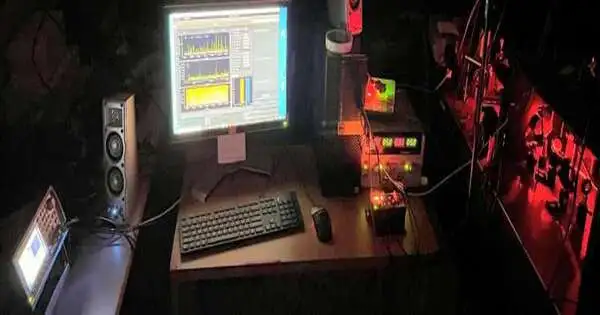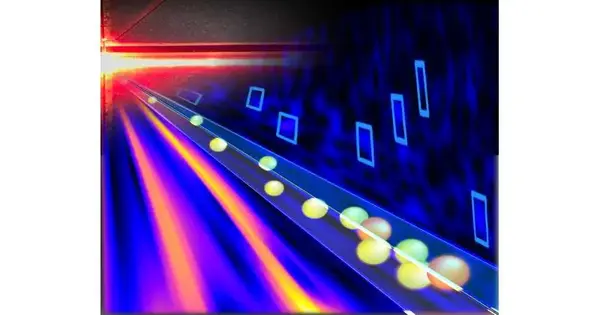Chip-based sensing devices that are utilized for the detection or analysis of substances have seen significant improvements from researchers. These accomplishments lay the groundwork for highly sensitive, portable, integrated optofluidic sensing devices that could be used to carry out a variety of medical tests simultaneously with completely different kinds of bioparticles—like DNA and viruses—at greatly varying concentrations.
New signal processing methods were applied to an optofluidic chip-based biosensor by researchers led by Holger Schmidt from the W.M. Keck Center for Nanoscale Optofluidics at the University of California, Santa Cruz (UCSC), as reported in the journal Optica. The seamless fluorescence detection of a variety of nanobeads in concentrations ranging from attomolar to nanomolar was made possible by these advancements. This makes the concentration range that these sensors can work in more than 10,000 times wider.
Schmidt stated, “This work is our latest step in developing integrated optofluidic sensing devices that work over a very wide range of concentrations and are sensitive enough to detect single biomolecules.” We have demonstrated that this can be accomplished using a single technique, which enables us to simultaneously measure and distinguish multiple particle types with varying concentrations.
The researchers developed a feedback loop that adjusts the input laser power in response to signals that are too large. They were able to detect powerful signals at high concentrations without overwhelming weak signals from other species at low concentrations because of this. Credit: Holger Schmidt, Department of Electrical and Computer Engineering, University of California, Santa Cruz
Developing a multipurpose testing device
Although numerous chip-based testing devices have been developed, the majority concentrate on a single target or type of test due to the diversity of biomolecules. The concentrations of various proteins used as disease biomarkers, for instance, can vary by more than ten orders of magnitude.
Together with Aaron Hawkins at Brigham Young University, Schmidt’s group is developing a testing platform that can be utilized for a variety of analyses. It is based on optofluidic chips, which are silicon or plastic chips that combine microfluidic channels with optics. A laser beam is used to illuminate particles, and a light-sensitive detector is used to measure the particles’ response.
The researchers have previously demonstrated that their platform can detect a wide range of particle types, including nucleic acids, proteins, viruses, bacteria, and cancer biomarkers, and that it has the sensitivity required to carry out a variety of analyses. However, to date, they have measured particles with high and low concentrations using distinct detectors and signal analysis methods. This was necessary due to the fact that when one type of particle is present at a very high concentration, it generates a very large response that overwhelms the signals from another type of particle that is present at low concentrations, which are much smaller.

Better signal processing
The researchers developed distinct signal modulation frequencies in order to simultaneously detect molecules present at both high and low concentrations. They distinguished single particles at low concentrations using high-frequency laser modulation, while at high concentrations, they detected large signals from many particles simultaneously using low-frequency laser modulation. The image depicts the operation of the bespoke control software and optical setup. Credit: Holger Schmidt, ECE Department, University of California, Santa Cruz.
These methods can be used to detect particles in both high and low concentrations simultaneously, even if the concentrations are unknown beforehand. They accomplished this by combining the following signal modulation frequencies: High recurrence laser tweak to recognize single particles at low fixations and low recurrence laser balance to identify huge signs from numerous particles at the same time at high focuses.
“Besides, we carried out a criticism circle that identifies when signs are truly huge and changes the information laser power likewise,” said Schmidt. “We are able to detect strong signals from other species at low concentrations without overwhelming the large signals from high concentrations. We were able to simultaneously detect particles of varying concentrations because of this.”
The scientists additionally applied a very quick calculation, which they have since evolved to distinguish single-molecule signals at low fixations. Additionally, machine learning assisted in the recognition of signal patterns, making it possible to accurately distinguish between various types of particles. These advancements in signal analysis are ideal for enabling device operation at the point of care, where data analysis in real time is required and signal quality can be low.
Distinguishing low and high concentrations
By pumping optofluidic biosensor chips with a solution of nanobeads at various concentrations and with various fluorescence colors, the researchers demonstrated their new signal analysis method. Despite the fact that their concentrations differed by more than 10,000 in the mixture, they were able to correctly identify the concentrations of the yellow-green and crimson beads.
“While this work propels a particular coordinated sensor that depends on optical fluorescence flags, the sign investigation strategy can be utilized with a period subordinate sign that covers a wide focus range,” said Schmidt. “This may include electrical sensors as well as various optical signals.”
The medical device company Fluxus Inc. is currently bringing the team’s optofluidic biosensing technology to market. The researchers are also working to modify their methods so that they can study molecular products from organoids made of artificial neuronal cell tissue. The UCSC Center for Live Cell Genomics, an NIH Center for Excellence in Genomic Science, is the home of this project, which has the potential to shed more light on topics like pediatric cancer and neurodegenerative diseases.
More information: Vahid Ganjalizadeh et al, Adaptive time modulation technique for multiplexed on-chip particle detection across scales, Optica (2023). DOI: 10.1364/OPTICA.489068





